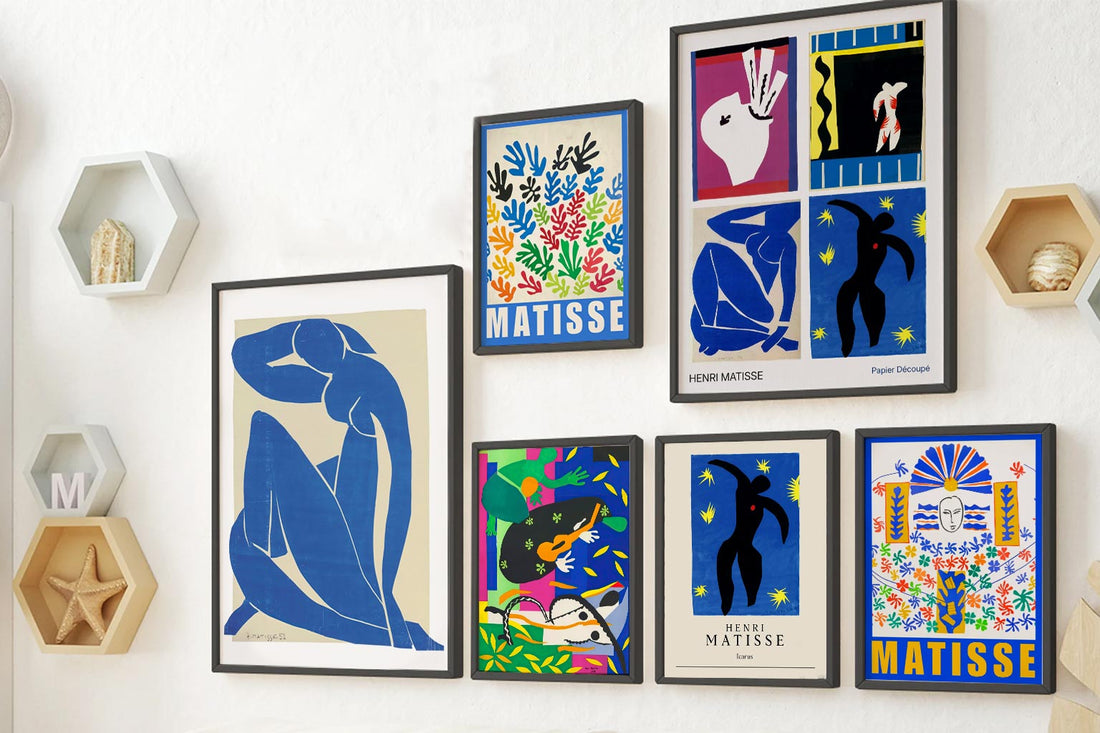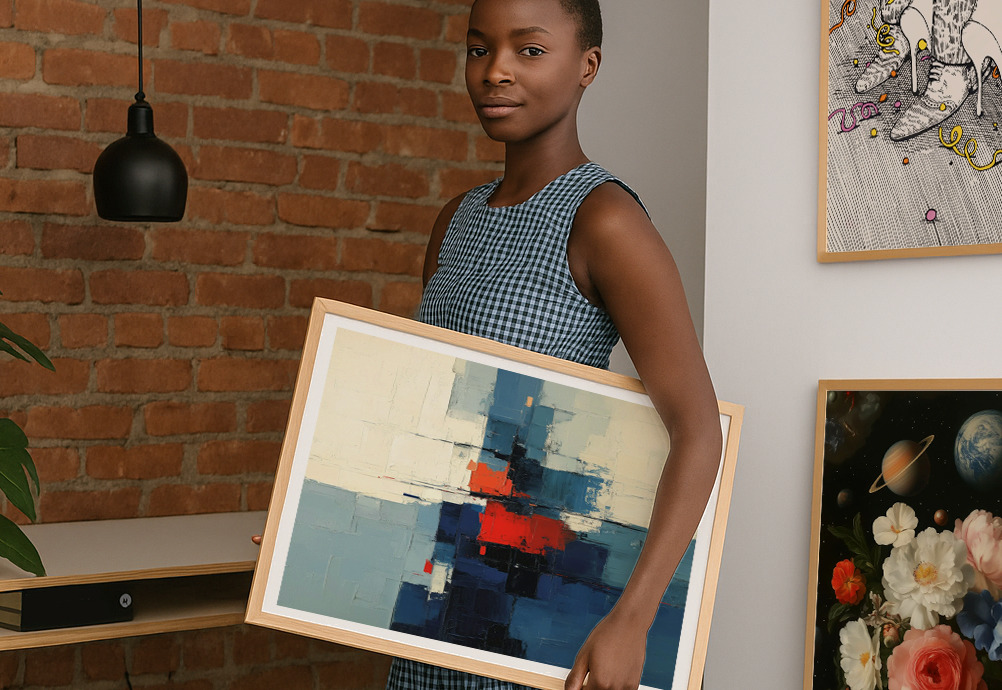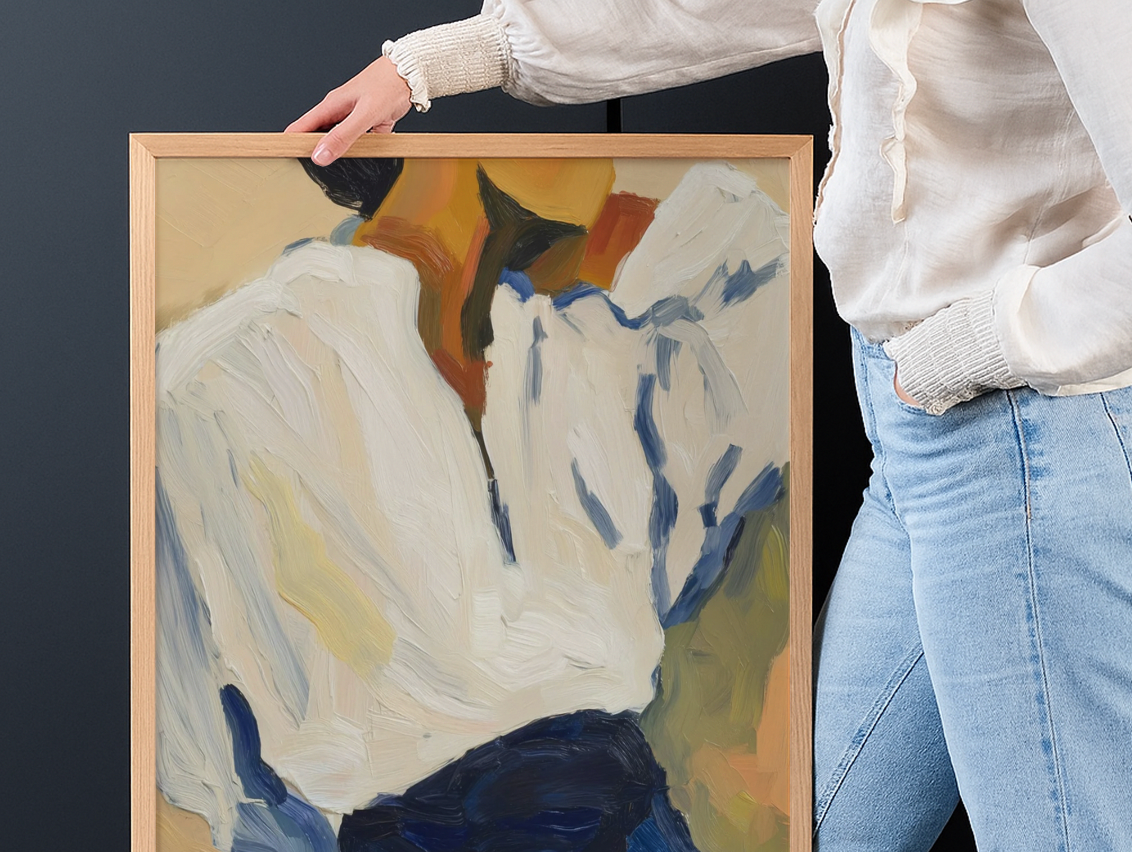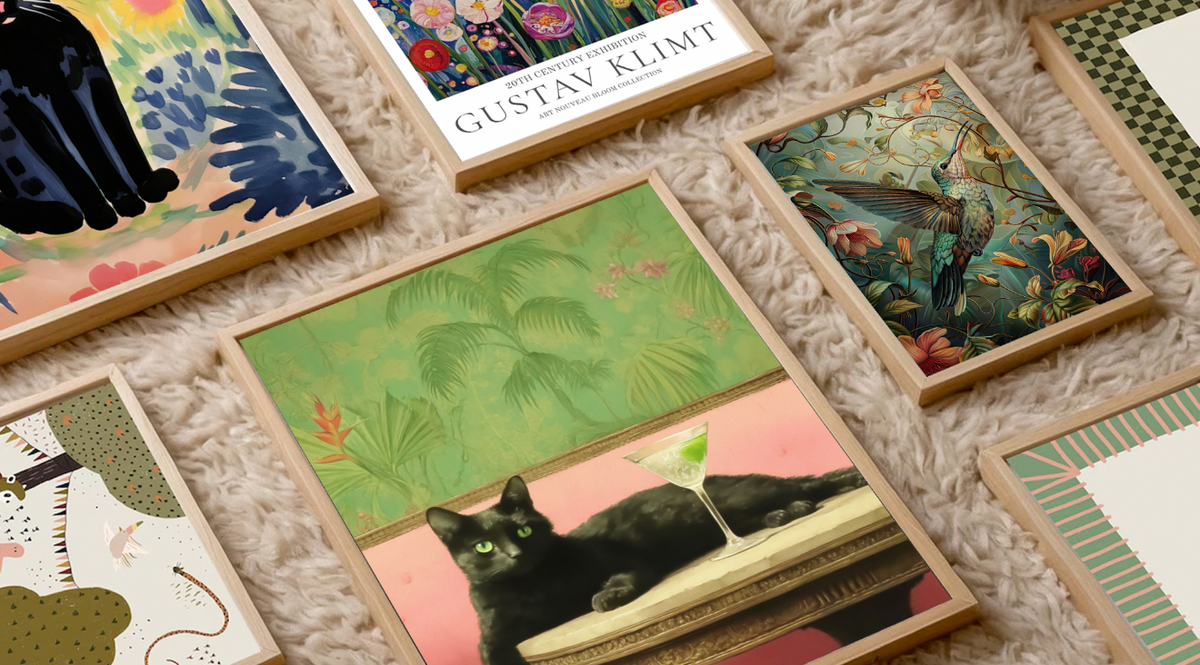Discovering Matisse: A Beginner's Guide to Cut-Outs
How to understand, style, and fall in love with the playful genius of Matisse's cut-outs.

You've probably seen them without knowing it. Those bold, bright shapes that look like someone cut colored paper with scissors and arranged them into pure joy.
That's exactly what they are. And they're some of the most celebrated artworks of the 20th century.
What are Matisse's cut-outs?
Henri Matisse started making cut-outs in the 1940s when he was in his seventies and too frail to paint at an easel. Instead of giving up art, he found a new way to create.
He painted large sheets of paper in vibrant colors, then cut them into shapes with scissors. Simple forms: spirals, leaves, dancers, birds. Then he arranged them into compositions that feel both spontaneous and perfectly balanced.
Matisse called it "drawing with scissors." He said he was finally able to draw directly in color.
The results were unlike anything anyone had seen before. Not quite painting, not quite sculpture. Something entirely new.

Why they feel so alive
There's something about cut-outs that makes you want to smile. Maybe it's the way the shapes seem to dance across the surface. Or how the colors vibrate next to each other.
Matisse used pure, saturated hues: cobalt blue, emerald green, bright orange, deep purple. Colors that feel like they're glowing from within.
The shapes themselves are deceptively simple. A spiral suggests movement. A leaf shape feels organic and alive. Human figures seem to be mid-dance, frozen in a moment of pure energy.
But here's what makes them genius: even though they're made from flat paper, they create a sense of depth and movement that rivals any traditional painting.
The Blue Nudes and beyond
Some of Matisse's most famous cut-outs are the Blue Nudes series. Four large compositions of female figures, all in the same brilliant blue, but each completely different in pose and energy.
Then there's "The Snail," a massive square composition made entirely of colored rectangles arranged in a spiral pattern. It shouldn't work, but it absolutely does.
"Jazz" was a portfolio of cut-outs Matisse made as illustrations for a book. Each one captures a different rhythm or mood, from circus performers to abstract patterns that seem to pulse with music.
These weren't sketches or studies. They were fully realized artworks that influenced everything from graphic design to fashion to interior decoration.

Why they work in modern homes
Cut-outs have become a staple in contemporary interiors, and it's easy to see why. They bring instant personality to any space without overwhelming it.
The bold shapes work beautifully with clean, modern lines. A Matisse-inspired print can soften the hard edges of contemporary furniture while adding a pop of color that feels intentional, not random.
They're also surprisingly versatile. In a minimalist space, a single cut-out print becomes a striking focal point. In a maximalist room, they play well with other patterns and colors without competing for attention.
Wall Art by Style: A Guide to Every Aesthetic breaks down how different art styles work in various interiors, but cut-outs have this unique ability to bridge different design approaches.
The color story
One reason cut-outs work so well in homes is their fearless use of color. Matisse wasn't trying to match anyone's sofa or coordinate with existing decor.
He was thinking about how colors make you feel. How blue can be both calming and energizing. How orange and pink together can create warmth without being aggressive.
This approach to color is liberating for anyone decorating their home. Instead of overthinking whether the art "goes" with the room, you can focus on whether it makes you feel good.
Choosing Art That Fits Your Personality explores this idea further, but cut-outs are perfect examples of art that prioritizes emotion over coordination.

Living with cut-outs
So how do you actually style these pieces in your home?
Natural light makes them sing. The colors become more vibrant, and the sense of movement becomes more pronounced. If you have a spot that gets good light during the day, that's where your cut-out should go.
They work beautifully in bedrooms, where the joyful energy can be the first thing you see in the morning. Or in dining rooms, where the bold shapes create conversation without being distracting.
Scale matters too. Cut-outs can handle being large. Don't be afraid of a substantial piece that makes a real statement on your wall.
Frame them simply. Clean lines, minimal frames, or even floating frames that don't compete with the artwork itself.

For first-time art buyers
If you're new to buying art, cut-outs are a great place to start. They're immediately appealing without being intimidating. They bring color and energy to a space without requiring deep art knowledge to appreciate.
Starter Art Prints for First-Time Buyers covers the basics of building a collection, but cut-outs offer something special: they're both sophisticated and accessible.
You can appreciate them for their pure visual impact, or you can dig deeper into their art historical significance. They work either way.
Finding your style
Not sure if cut-outs are for you? Think about how you respond to color and movement.
If you love bold choices and aren't afraid of making a statement, cut-outs might be perfect. If you prefer subtle, muted tones, they might feel too energetic.
But here's the thing: Matisse made cut-outs in all kinds of color combinations. Some are bright and exuberant, others are more restrained. There's probably a cut-out style that speaks to your particular taste.
Find Your Art Style: Minimalist, Maximalist, or Boho? can help you figure out what resonates with you, but don't let categories limit you. Sometimes the best art choices are the ones that surprise you.

The joy factor
At the end of the day, that's what Matisse's cut-outs are about: joy. Pure, uncomplicated happiness expressed through color and form.
In a world that can feel heavy and complicated, there's something powerful about hanging a piece of art that radiates positivity.
Matisse made these works when he was dealing with serious health issues and the upheaval of World War II. But instead of reflecting that darkness, he created something that celebrates life and beauty.
That energy translates into your living space. A cut-out on your wall becomes a daily reminder that beauty exists, and that sometimes the simplest approaches create the most powerful results.

Where to start
Ready to explore this iconic art style? Browse Matisse-Inspired Prints in the Fab collection and see which shapes and colors speak to you.
Remember, you don't need to understand everything about art history to know what makes you happy. Trust your instincts, and let a little of Matisse's joyful energy into your home.
Fab products featured in this blog
-
Matisse Pink Cutout Poster Art Print
Translation missing: en.products.product.sale_price From €16,95€22,95 -
Blue Figure by Matisse Art Print
Translation missing: en.products.product.sale_price From €16,95€22,95 -
Matisse Paper Cutouts Art Print
Translation missing: en.products.product.sale_price From €16,95€22,95 -
Blue Figure by Matisse Canvas Print
Translation missing: en.products.product.sale_price From €63,95€91,95 -
Blue Nude by Henri Matisse Art Print
Translation missing: en.products.product.sale_price From €16,95€22,95 -
Bold Blue Minimal Curve Art Print
Translation missing: en.products.product.sale_price From €16,95€22,95 -
Catisse Matisse Cat & Woman Art Print
Translation missing: en.products.product.sale_price From €16,95€22,95 -
Botanical Cut-Outs Paradise Art Print
Translation missing: en.products.product.sale_price From €16,95€22,95 -
Botanical Cut Out Garden Art Print
Translation missing: en.products.product.sale_price From €16,95€22,95 -
Henri Matisse Knife Thrower Art Print
Translation missing: en.products.product.sale_price From €16,95€22,95 -
Henri Matisse – Icarus Art Print
Translation missing: en.products.product.sale_price From €16,95€22,95 -
Henri Matisse – Icarus Art Print
Translation missing: en.products.product.sale_price From €16,95€22,95 -
Henri Matisse – The Knife Thrower Art Print
Translation missing: en.products.product.sale_price From €16,95€22,95 -
Henri Matisse, Cut Outs, Paper Cuts Art Print
Translation missing: en.products.product.sale_price From €16,95€22,95 -
Henri Matisse, Memory of Oceania Art Print
Translation missing: en.products.product.sale_price From €16,95€22,95 -
Matisse Apollo 13 Paper Cuts Joyful Collage Art Print
Translation missing: en.products.product.sale_price From €16,95€22,95 -
Matisse Blue Nude Elegance Art Print
Translation missing: en.products.product.sale_price From €16,95€22,95 -
Matisse Color Cut-Outs Art Print
Translation missing: en.products.product.sale_price From €16,95€22,95 -
Matisse Curves in Tokyo Art Print
Translation missing: en.products.product.sale_price From €16,95€22,95 -
Matisse Cut-Outs Joy Art Print
Translation missing: en.products.product.sale_price From €16,95€22,95 -
Matisse Lilac Paper Cut Art Print
Translation missing: en.products.product.sale_price From €16,95€22,95 -
Matisse Papiers Decoupes Paper Cuts Night Art Print
Translation missing: en.products.product.sale_price From €16,95€22,95 -
Matisse Red Cut-Outs Art Print
Translation missing: en.products.product.sale_price From €16,95€22,95 -
Matisse Flowing Forms Collection Art Print
Translation missing: en.products.product.sale_price From €16,95€22,95 -
Henri Matisse, Sorrow of The King, Cut Out Art Print
Translation missing: en.products.product.sale_price From €16,95€22,95 -
Henri Matisse – Icarus Art Print
Translation missing: en.products.product.sale_price From €16,95€22,95 -
Henri Matisse Blue Nude Art Print
Translation missing: en.products.product.sale_price From €16,95€22,95 -
Henri Matisse Blue Nude Art Print
Translation missing: en.products.product.sale_price From €16,95€22,95 -
Henri Matisse The Circus Art Print
Translation missing: en.products.product.sale_price From €16,95€22,95 -
Henri Matisse – The Clown Art Print
Translation missing: en.products.product.sale_price From €16,95€22,95 -
Matisse Blue Figure Nude Art Print
Translation missing: en.products.product.sale_price From €16,95€22,95 -
Matisse Blue Nude Flow Art Print
Translation missing: en.products.product.sale_price From €16,95€22,95 -
Matisse Flowing Forms Collection Canvas Print
Translation missing: en.products.product.sale_price From €63,95€91,95 -
Matisse Pastel Paper Shapes Art Print
Translation missing: en.products.product.sale_price From €16,95€22,95 -
Matisse-Inspired Cutouts Papiers Decoupes Art Print
Translation missing: en.products.product.sale_price From €16,95€22,95 -
Matisse-Inspired Pink Cutouts Papiers Decoupes Art Print
Translation missing: en.products.product.sale_price From €16,95€22,95
More from The Frame
More stories, insights, and behind-the-scenes looks at the art that transforms your space
Top Wall Art Trends for 2025: What's In, What's...
Trends aren't rules to follow blindly. They're signals about where our collective taste is heading, what's capturing our imagination, and what feels fresh right now. The wall art trending in...
Art for Gifting: How to Choose a Print for Some...
Giving someone art is either incredibly thoughtful or slightly terrifying. There's no middle ground. On one hand, you're giving them something beautiful that will live in their home for years....
9 Art Prints That Instantly Elevate Any Living ...
You know that feeling when you walk into a beautifully styled living room and everything just feels right? It's not the expensive sofa or the perfect rug. It's usually the...






































